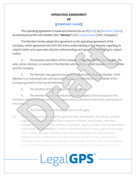Your Ultimate Guide to Understanding Subordination Agreements
In the complex and dynamic world of business, financial contracts such as subordination agreements often lie at the heart of smooth operations and...
5 min read
LegalGPS : July 25, 2024 at 1:10 PM
Our lives are filled with everyday agreements. You've probably agreed to meet a friend for lunch, or help a neighbor mow their lawn. But when it comes to business and financial transactions, an agreement should be more than just a promise. It should be concrete, legally enforceable, and well-documented. This brings us to Seller Note Subordination Agreements.

Legal GPS templates are drafted by top startup attorneys and fully customizable.
 What is a Seller Note Subordination Agreement?
What is a Seller Note Subordination Agreement?A Seller Note Subordination Agreement is a legally binding contract coming into play when a business owner is selling their business and providing financing for the buyer. In this agreement, the seller (lender) acknowledges that they will be repaid after the senior debt of the business is fully settled. This means that their claim to the debt is 'subordinated' or ranked lower when compared to other creditors.
Now that we've refreshed your memory on the concept, let's explore the structure of such an agreement and learn how to fill it out effectively.
A standard Seller Note Subordination Agreement is composed of several sections, covering different aspects of the transaction. We'll go through each of them, discussing what you should include and how you should fill it out.
Parties Involved: This section identifies the main players in the agreement: the seller (lender), the buyer (borrower), and the senior creditor. Make sure to specify their full legal names, roles in the agreement, and complete addresses. By doing so, you'll set the foundation for the remainder of the document.
Loan Terms: After identifying the parties, you should clarify the terms of the seller-financed loan. Detail the principal amount, interest rate, payment schedule, maturity date, and any collateral. This information should be clear and precise, as it governs the financial obligations of the borrower and the lender's claim.
Subordination Clause: This critical section outlines the subordination process itself. You'll need to mention that the seller agrees that the senior creditor holds priority over their claim in case of a default. Include a clear statement indicating your agreement to the subordination of your claim.
Default and Remedies: To fully complete the agreement, you should specify the conditions under which the borrower is considered to be in default and describe the remedies available to the seller in such cases. This helps all parties understand their rights and obligations when it comes to non-payment or breach of contract.
Signatures and Dates: Finally, end the agreement with spaces for all parties to sign and date. It's important for all signatures to be notarized, ensuring that your agreement is legally binding and enforceable.
Armed with this knowledge and understanding of a Seller Note Subordination Agreement, you'll feel more comfortable drafting one to suit your individual circumstances. However, we still highly recommend consulting with a legal professional or using professionally-crafted templates to ensure your agreement is complete, watertight, and meets all legal requirements.
This document effectively pushes the seller's claim further back in line, making their debt subordinated or lower in priority compared to other debts. So, if things go south and the business has to liquidate its assets, the seller gets paid only after all the senior creditors have received their due.

Protect your business with our complete legal subscription service, designed by top startup attorneys.
Depicting a real-world example can help provide clarity on this. Imagine John wants to sell his business to Amy, but Amy doesn't have the full buying amount. Here's what John can do. He can ask for a down payment from Amy and finance the remaining amount himself, allowing Amy to pay him back over time with interest.
This kind of seller-financed deal often involves a Seller Note Subordination Agreement. In the agreement, John, as the seller, subordinates his claim on Amy's business to other, senior creditors like a bank or suppliers. This ensures that if Amy's business cannot repay all its debts, the other creditors get paid first.
Imagine, for example, that Amy's business is insolvent and John has lent her money for the purchase. If John does not subordinate his claim on the business to other creditors, they could seize and sell off Amy's property in order to recoup their losses.
But why would anyone willingly agree to a situation where they get settled last? There are multiple benefits to why a Seller Note Subordination Agreement becomes an attractive proposition for both buyer and seller:
Creativity in Closing Deals: By offering to finance a portion of the sale price, sellers can close deals that might otherwise never happen. This can be particularly helpful if the business doesn't show an attractive enough profit margin to get a bank loan, or if the buyer is having difficulty securing external finance.
Potential for Higher Sales Price: In the previously mentioned scenario, sellers may often command a higher price for their business. This is because they simplify the buyer's process and share the risk, which can also help build trusting relationships.
Regular Payments: The seller can reap the benefits of regular payments with interest over time, providing a steady income stream, particularly during retirement.
Tax Advantages: There may also be tax benefits associated with this type of transaction.
Reading this far, you could definitely see the potential benefits a Seller Note Subordination Agreement could bring to a transaction. But how do you go about writing one?
Your agreement should begin by mentioning who is involved in the contract. As the person writing the agreement, your details should appear first. Include your full legal name or your business name, and complete address.
Next, mention the buyer, the person you'll be selling the business to. Again, use full legal names and complete addresses. Lastly, include the name and address of the senior creditor. A senior creditor is the primary lender or the institution that holds precedence over payoff in case of default.
Seller: John Doe
Address: 1234 Legal Road, Justice Town, Law State, 90001
Buyer: Jane Doe
Address: 5678 Business Blvd, Market City, Trade State, 94501
Senior Lender: ABC Bank
Address: 9012 Trust Ave, Money City, Finance State, 97531
Clearly define the loan's terms in the agreement. This includes the total loan amount, interest rate, payment schedule(how frequently payments should be made), maturity date(the date the total loan amount should be fully paid), and any collateral attached to the loan.
Loan Amount: $200,000
Interest Rate: 4.5%
Payment Schedule: Monthly
Maturity Date: September 30, 2025
Get Your Seller Note Subordination Agreement Template
with a Legal GPS Subscription
The essence of a Seller Note Subordination Agreement is the process of subordination. The seller must define their agreement to be a subordinate in relation to the senior lender. Specify that in the event of the buyer's insolvency, the senior lender will be paid off before the seller has any claim to the remaining funds.
"The Seller agrees to subordinate their claim on the said business to the Senior Lender (ABC Bank) until all senior debt is paid off."
Round up the agreement by providing places for all parties involved to sign and date. It's recommended that these signatures are notarized to ensure that they're legally binding.
Seller:
John Doe Date
Buyer:
Jane Doe Date
Senior Lender:
ABC Bank Date
A Seller Note Subordination Agreement often involves intricate details that tie in with other legal documents like Promissory Notes and Security Agreements. Hence, it's often recommended to take legal guidance or use trusted, professionally created templates.
Pre-made templates can be cost-saving and provide an efficient way to understand and draft these legal documents. Business owners with proper guidance can use them as a stepping stone before approaching legal experts.
At Legal GPS, we have a wide range of industry-specific templates, including the Seller Note Subordination Agreement, crafted by experts. With our templates, we save you the worry and stress that comes with legal details. We hope you found this comprehensive guide not only informative but insightful, inspiring you to navigate the legal landscape of business with ease.
A friendly handshake or a gentleman's promise is nice, but when it comes to your business, make sure your agreements are legally sound, properly documented, and (most importantly) in your best interest.
Get Legal GPS's Seller Note Subordination Agreement Template Now

Protect your business with our complete legal subscription service, designed by top startup attorneys.

In the complex and dynamic world of business, financial contracts such as subordination agreements often lie at the heart of smooth operations and...

Navigating the financial ecosystem as a growing business can be challenging. However, with the right contracts on hand, like Junior Lender Friendly...

Welcome to another of our informative blog posts aimed at demystifying complex legal topics. Today, we're addressing something that many solo...